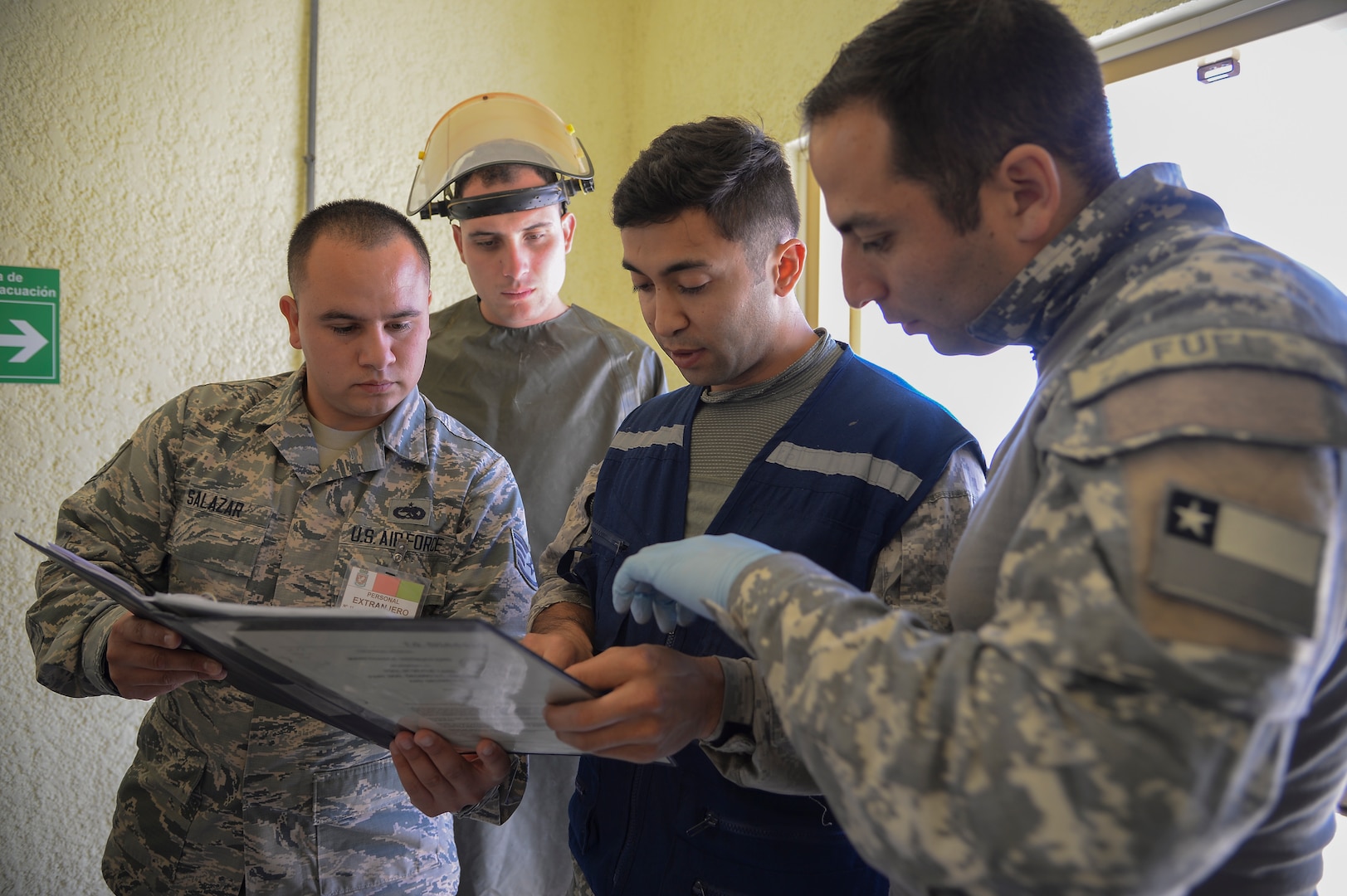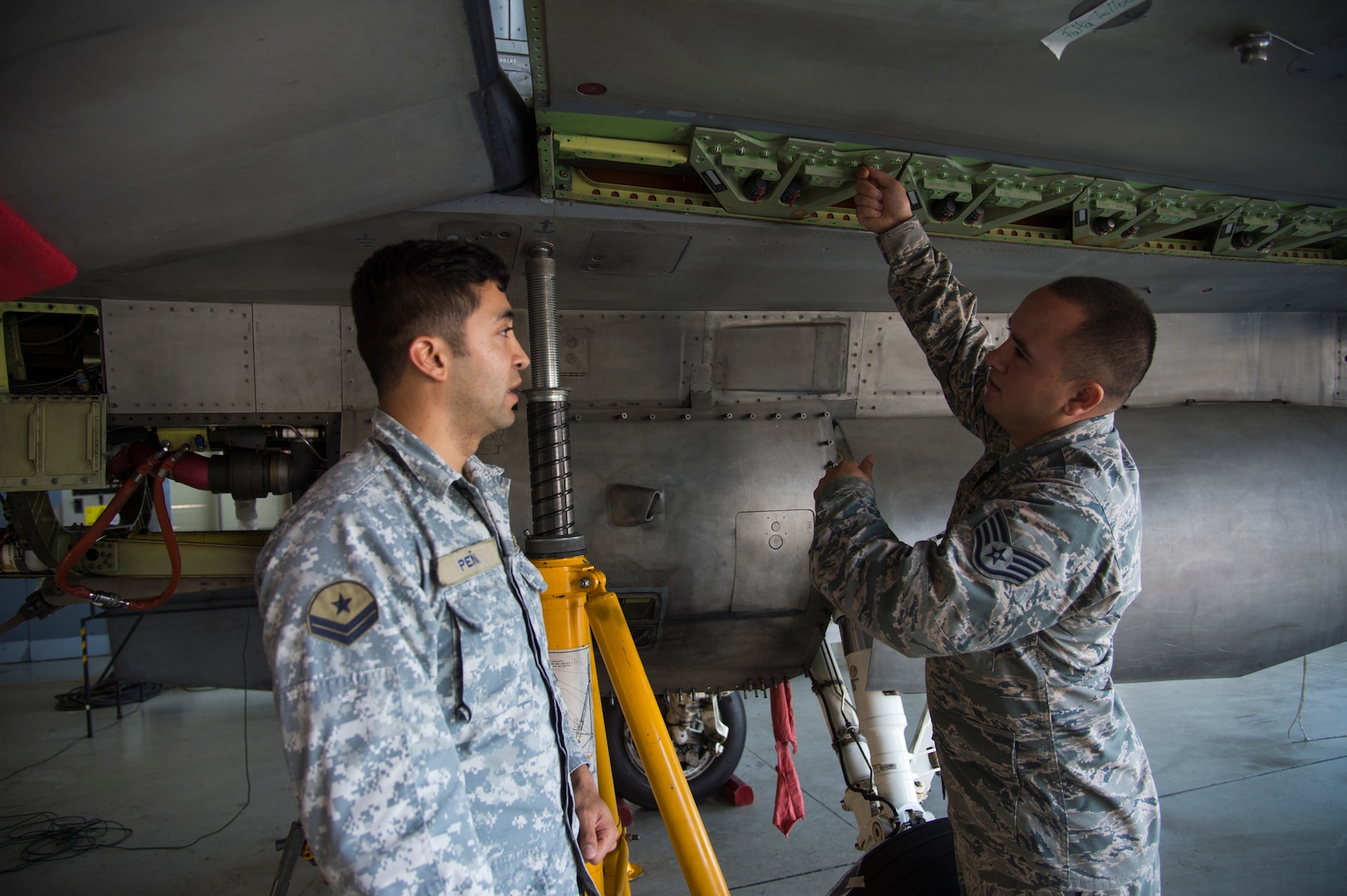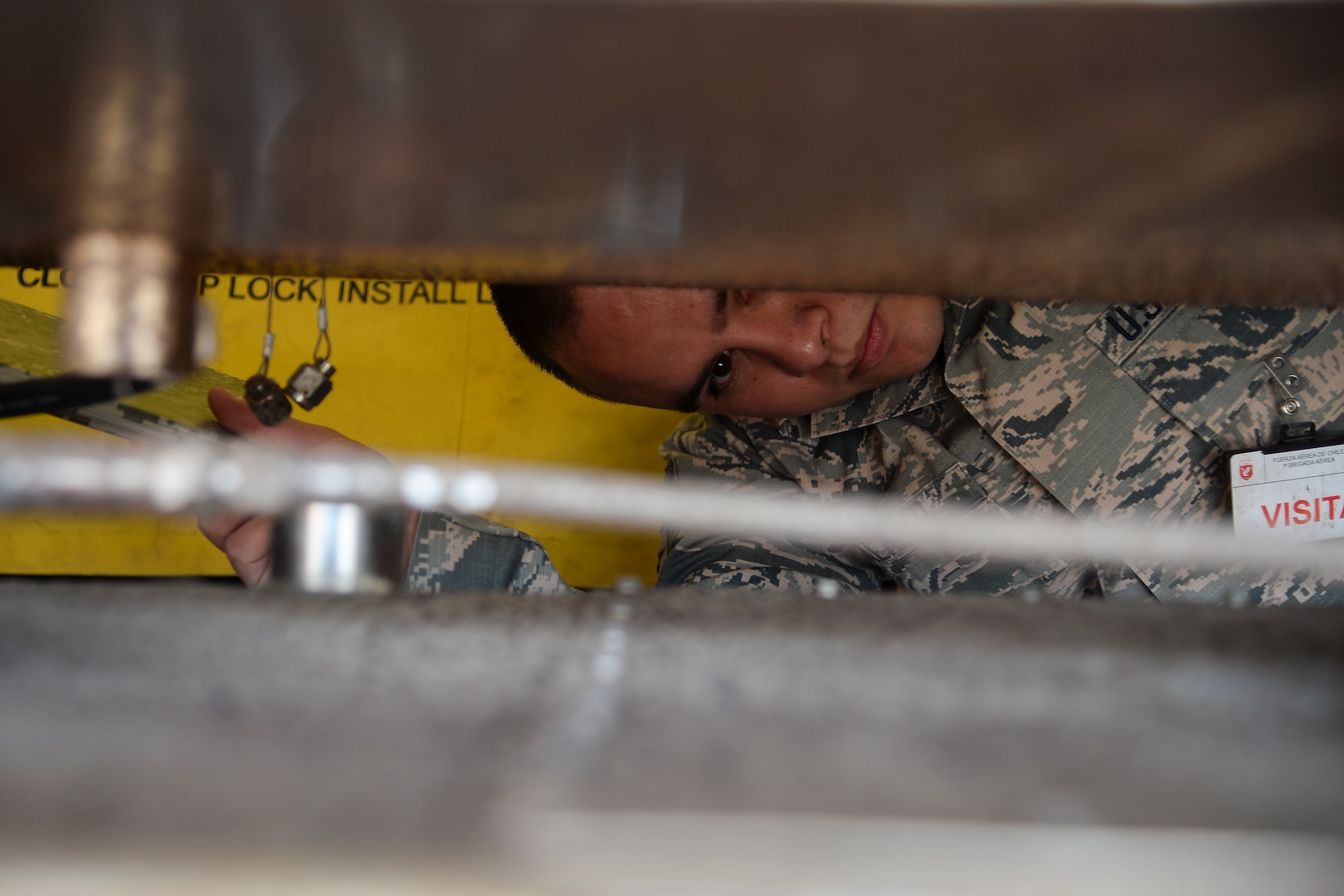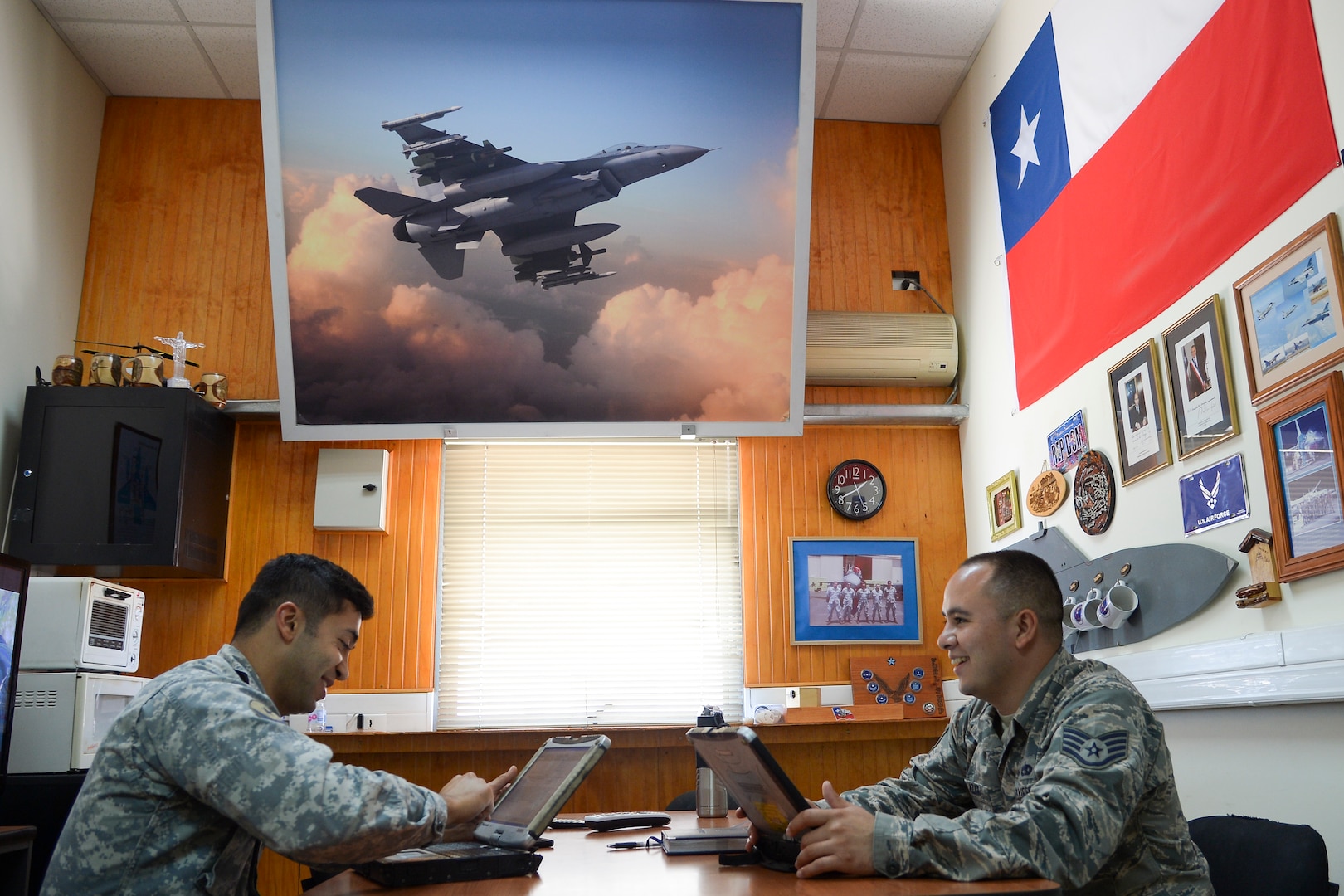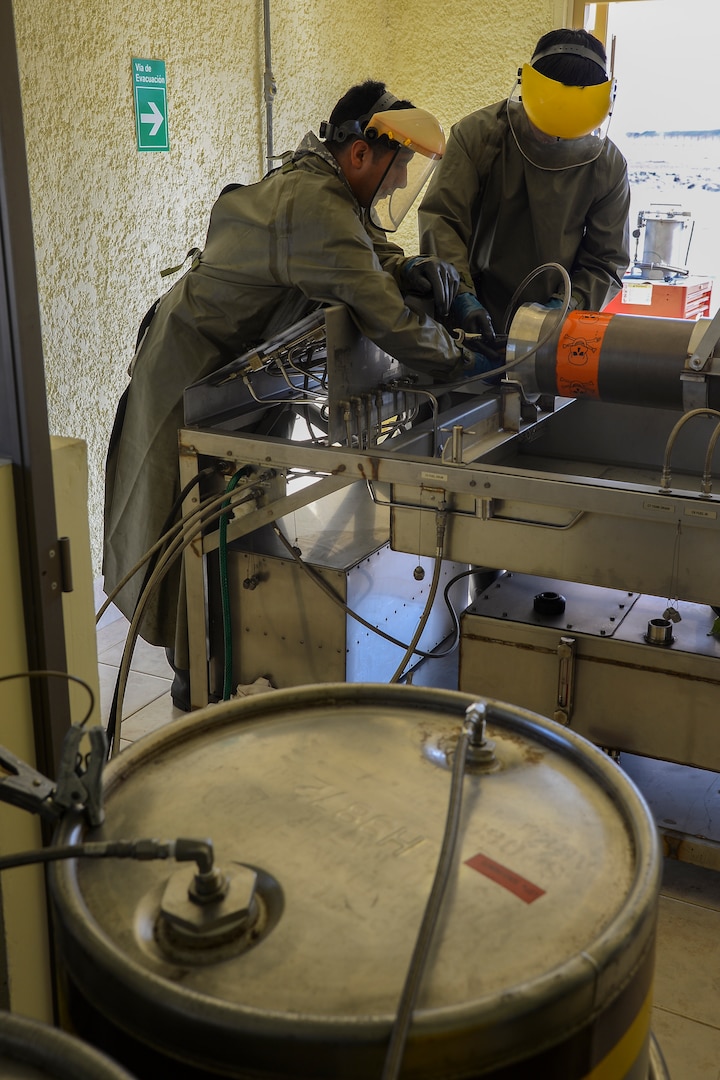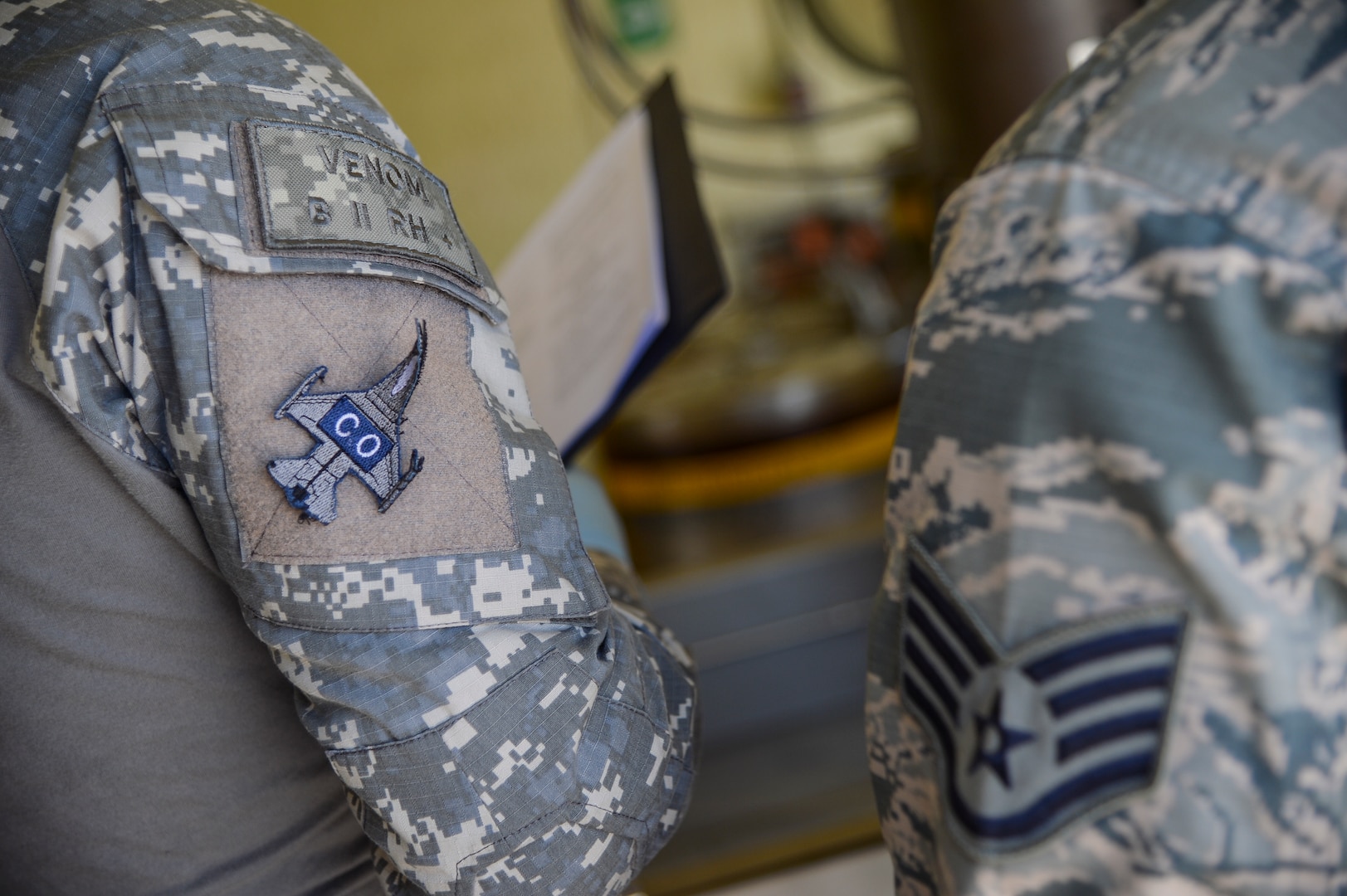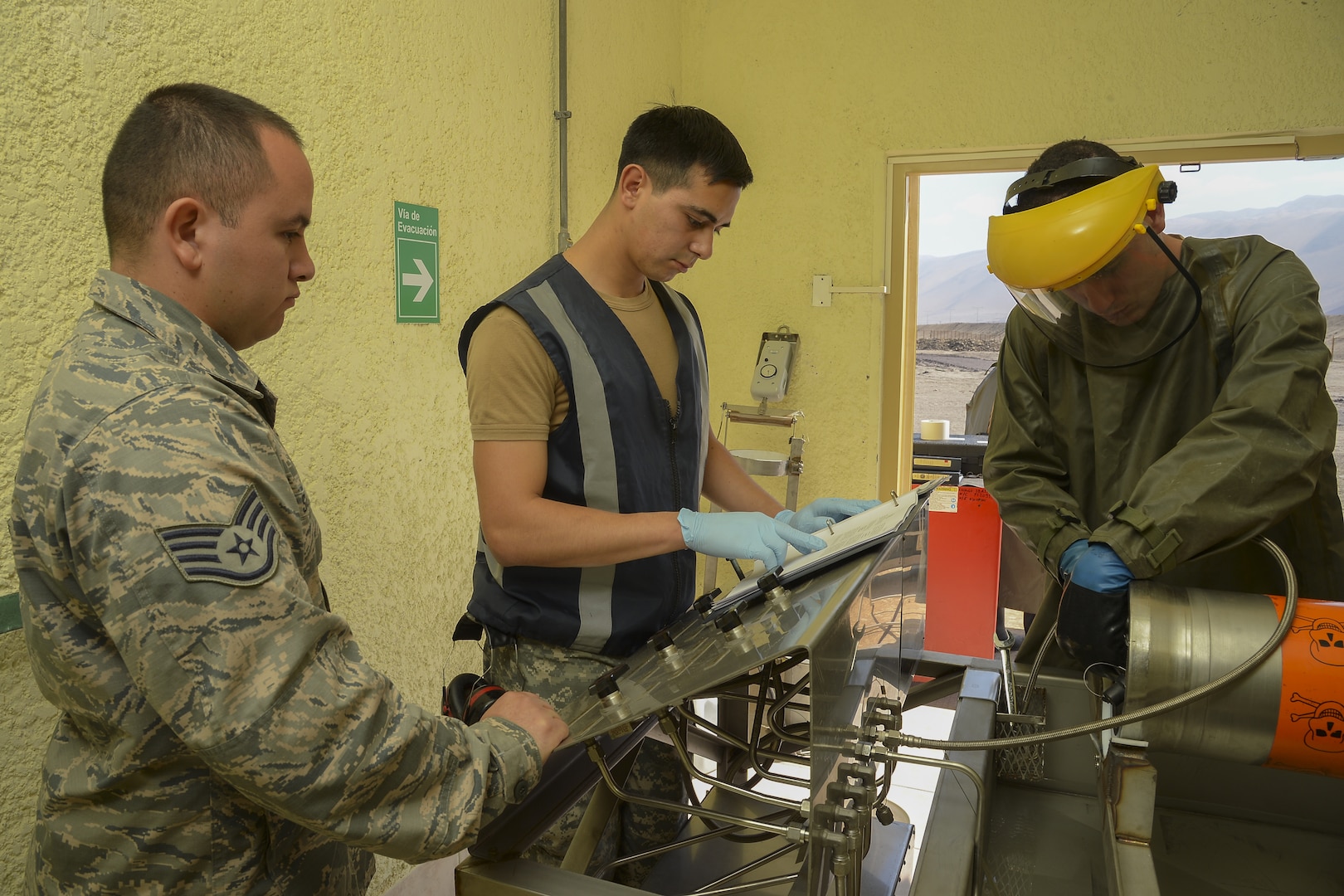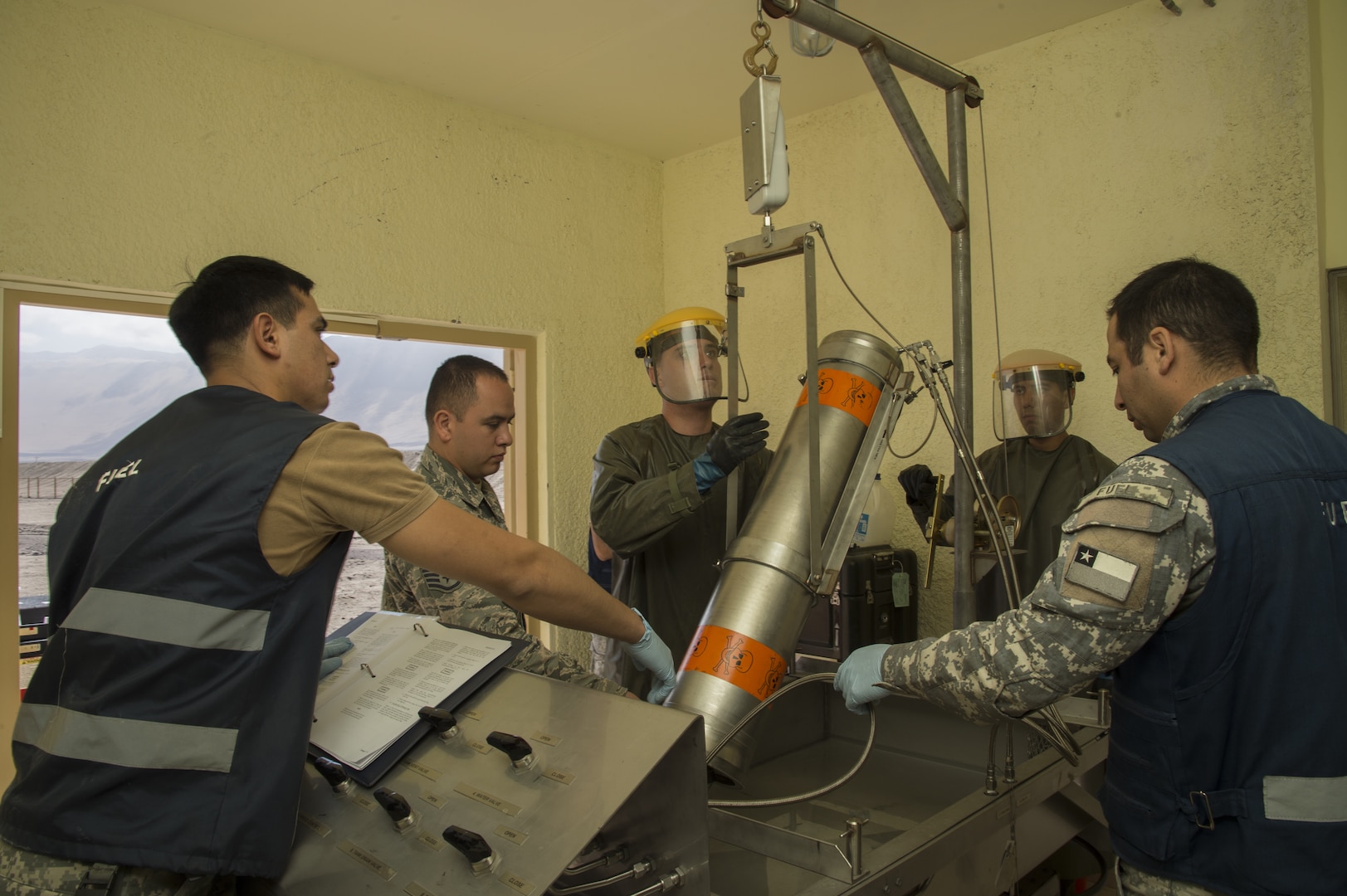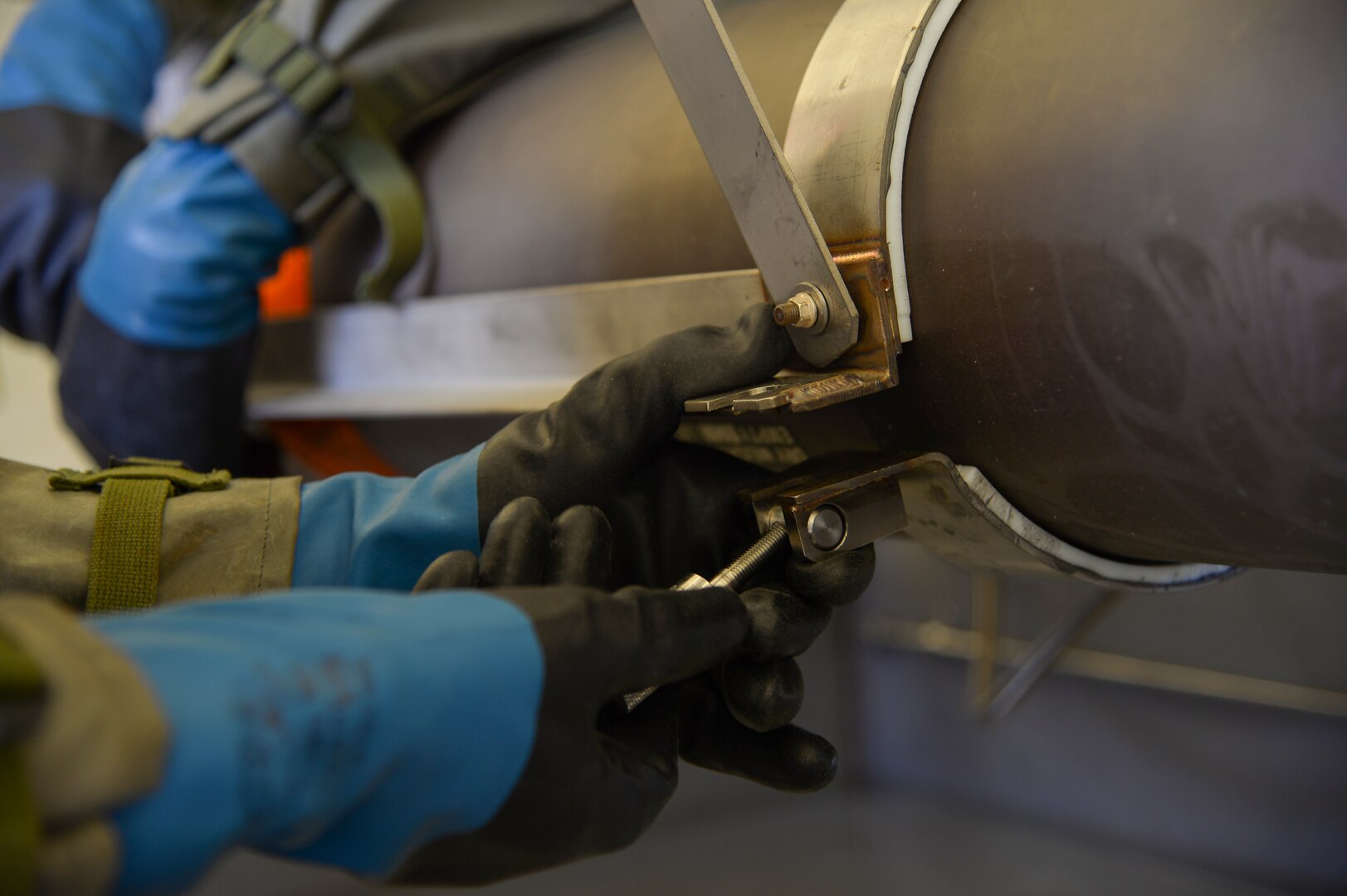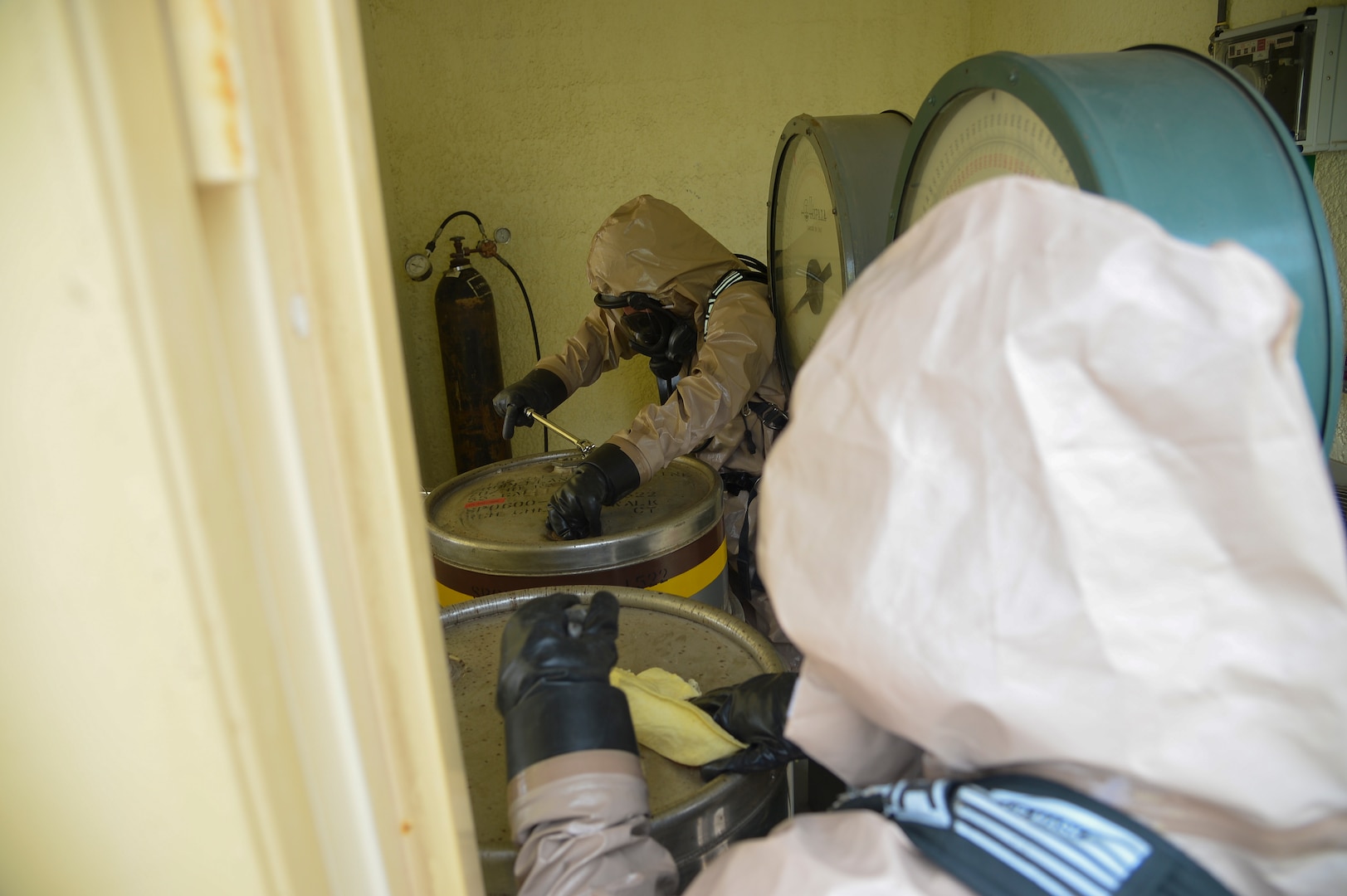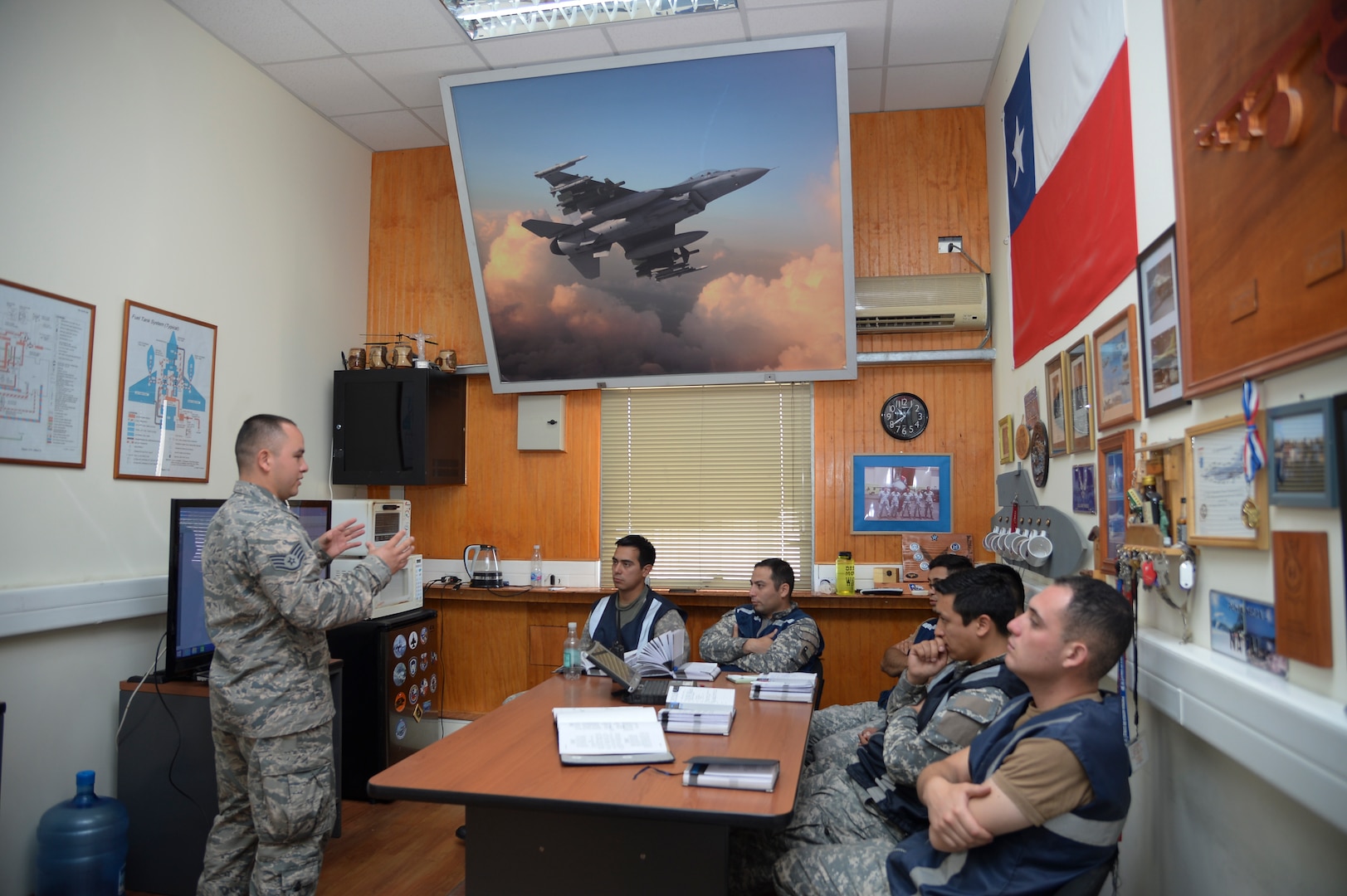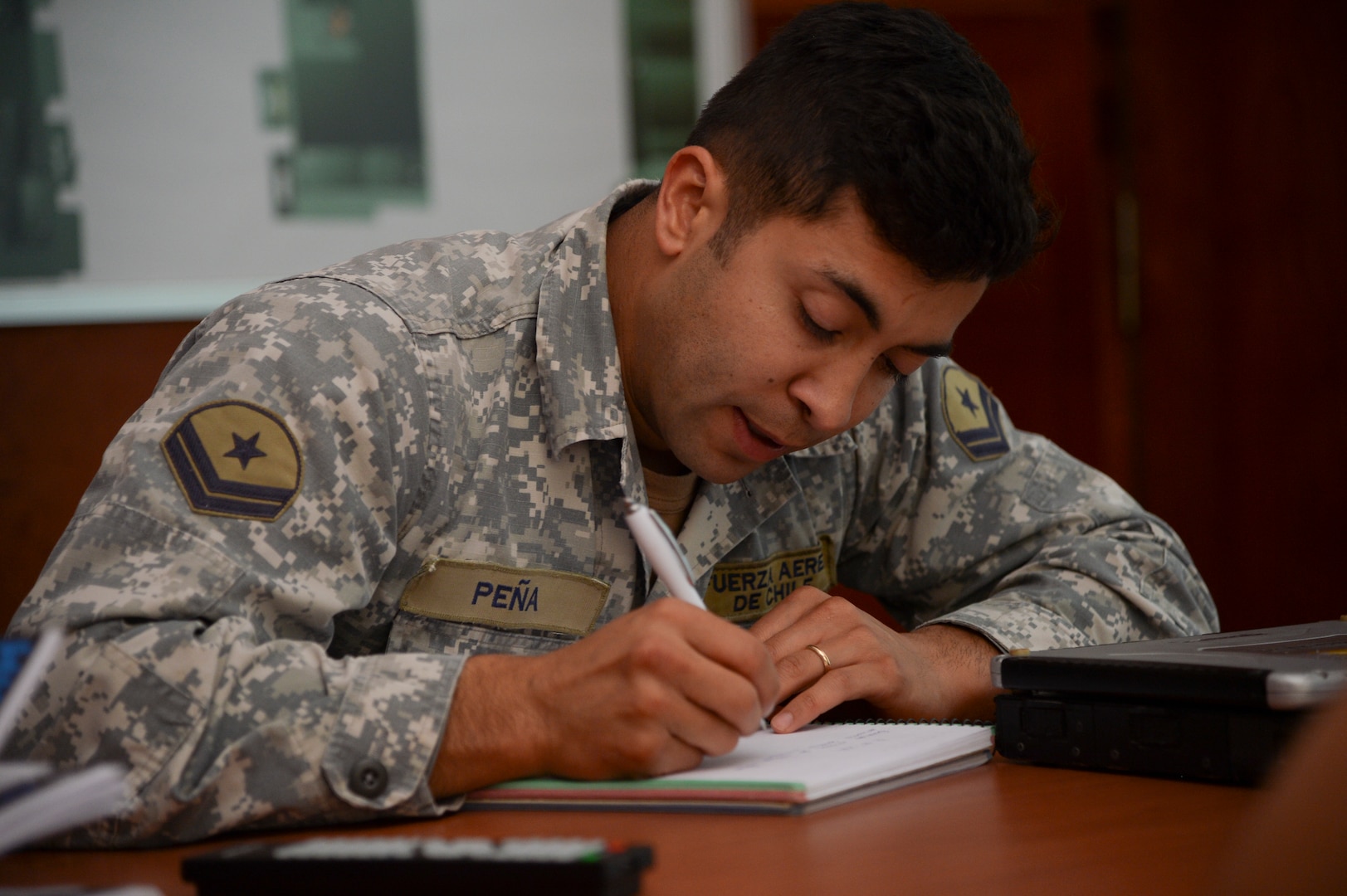Hydrazine Mobile Training Team in Chile
U.S. Staff Sgt. Daniel Salazar, 56th Maintenance Group hydrazine Mobile Training Team instructor, reviews hydrazine technical orders with Chilean Air Force members during hands-on instruction of hydrazine servicing at Los Condores Air Base, Chile, Nov. 8, 2018. The Hydrazine MTT instructed and observed the Chilean Airmen as they prepared unserviceable tanks for depo, replaced parts on tanks and refueled tanks. (U.S. Air Force photo by Tech. Sgt. Angela Ruiz)
Hydrazine Mobile Training Team in Chile
.S. Air Force Staff Sgt. Daniel Salazar, 56th Maintenance Group hydrazine Mobile Training Team instructor, and a Chilean Air Force member inspect a Chilean F-16 Fighting Falcon for fuel leaks at Los Condores Air Base, Chile, Nov. 6, 2018. In-between hydrazine training the Chilean Airmen had real world fuels concerns to address and requested Salazar’s expertise in troubleshooting the issues. (U.S. Air Force photo by Tech. Sgt. Angela Ruiz)
Hydrazine Mobile Training Team in Chile
U.S. Staff Sgt. Daniel Salazar, 56th Maintenance Group hydrazine Mobile Training Team instructor, inspects a corroded hydrazine servicing stand at Los Condores Air Base, Chile, Nov. 5, 2018. The two-man hydrazine Mobile Training Team taught seven Chilean fuel Airmen how to properly assemble, operate and maintain their new hydrazine servicing stand. Due to environmental conditions their previous hydrazine servicing stand became corroded and unserviceable.
Hydrazine Mobile Training Team in Chile
U.S. Air Force Staff Sgt. Daniel Salazar, 56th Maintenance Group hydrazine Mobile Training Team instructor, and a Chilean Air Force member review hydrazine technical orders at Los Condores Air Base, Chile, Nov. 6, 2018. The Chilean Air Force fuel Airmen read English technical orders but don’t often have the opportunity to practice speaking English. The Hydrazine MTT instructed in English and had limited Spanish interpretation since only one of the team members was fluent in Spanish. (U.S. Air Force photo by Tech. Sgt. Angela Ruiz)
Hydrazine Mobile Training Team in Chile
Chilean Air Force members depressurize a hydrazine tank during a U.S. Air Force hydrazine Mobile Training Team hands-on instruction at Los Condores Air Base, Chile, Nov. 8, 2018. The Hydrazine MTT instructed and observed the Chilean Airmen as they prepared unserviceable tanks for depo, replaced parts on tanks and refueled tanks. (U.S. Air Force photo by Tech. Sgt. Angela Ruiz)
Hydrazine Mobile Training Team in Chile
An F-16 Fighting Falcon fuel patch is worn on the arm of a Chilean Air Force as a U.S. Air Force Staff Sergeant stands next to him during a hydrazine Mobile Training Team hands-on training at Los Condores Air Base, Chile, Nov. 8, 2018. The Chilean Air Force requested the hydrazine MTT to refresh their Airmen’s knowledge and understanding of a hydrazine servicing stand and servicing hydrazine tanks. (U.S. Air Force photo by Tech. Sgt. Angela Ruiz)
Hydrazine Mobile Training Team in Chile
U.S. Staff Sgt. Daniel Salazar, 56th Maintenance Group hydrazine Mobile Training Team instructor, and a Chilean Air Force member refurbish a quick disconnect part for a hydrazine tank at Los Condores Air Base, Chile, Nov. 8, 2018. The hydrazine MTT instructed and observed the Chilean Airmen as they prepared unserviceable tanks for depo, replaced parts on tanks and refueled tanks. (U.S. Air Force photo by Tech. Sgt. Angela Ruiz)
Hydrazine Mobile Training Team in Chile
A Chilean Air Force member remove safety wire in preparation to refurbish hydrazine tank during a U.S. Air Force hydrazine Mobile Training Team hands-on training at Los Condores Air Base, Chile, Nov. 13, 2018. Personnel protective equipment must be worn when working closely with hydrazine tanks to prevent injury in the event of a hydrazine spill. Hydrazine is extremely flammable, combustible and cancerous. (U.S. Air Force photo by Tech. Sgt. Angela Ruiz)
Hydrazine Mobile Training Team in Chile
U.S. Staff Sgt. Daniel Salazar, 56th Maintenance Group hydrazine Mobile Training Team instructor, monitors Chilean Air Force members as they service a hydrazine tank at Los Condores Air Base, Chile, Nov. 13, 2018. The Chilean Air Force requested a U.S. Air Force Hydrazine Mobile Training Team to refresh their Airmen’s knowledge and understanding of a hydrazine servicing stand and servicing hydrazine tanks. (U.S. Air Force photo by Tech. Sgt. Angela Ruiz)
Hydrazine Mobile Training Team in Chile
U.S. Staff Sgt. Daniel Salazar, 56th Maintenance Group hydrazine Mobile Training Team instructor, monitors Chilean Air Force members as they properly record the weight of a hydrazine tank at Los Condores Air Base, Chile, Nov. 13, 2018. Hydrazine is a back-up fuel used in F-16 Fighting Falcons that allows a pilot to regain control in the event of an electrical or hydraulic failure. When the hydrazine is released it creates a chemical reaction that allows the pilot to manually maneuver the aircraft in order to land it safely. (U.S. Air Force photo by Tech. Sgt. Angela Ruiz)
Hydrazine Mobile Training Team in Chile
Chilean Air Force members assemble a clamp to a hydrazine tank during a U.S. Air Force hydrazine Mobile Training Team hands-on instruction with the Chilean Airmen at Los Condores Air Base, Chile, Nov. 8, 2018. The Chilean Air Force requested the hydrazine MTT to refresh their Airmen’s knowledge and understanding of a hydrazine servicing stand and servicing hydrazine tanks. (U.S. Air Force photo by Tech. Sgt. Angela Ruiz)
Hydrazine Mobile Training Team in Chile
Chilean Air Force members install a hydrazine tank to a servicing stand during a U.S. Air Force hydrazine Mobile Training Team hands-on instruction at Los Condores Air Base, Chile, Nov. 8, 2018. The hydrazine MTT instructed and observed the Chilean Airmen as they prepared unserviceable tanks for depo, replaced parts on tanks and refueled tanks. (U.S. Air Force photo by Tech. Sgt. Angela Ruiz)
Hydrazine Mobile Training Team in Chile
Chilean Air Force members and a U.S. Air Force Airman wear chemical suites to switch hydrazine drums for a hydrazine servicing stand at Los Condores Air Base, Chile, during a hydrazine Mobile Training Team hands-on instruction Nov. 8, 2018. Personnel protective equipment must be worn when working closely with hydrazine tanks to prevent injury in the event of a hydrazine spill. Hydrazine is extremely flammable, combustible and cancerous. (U.S. Air Force photo by Tech. Sgt. Angela Ruiz)
Hydrazine Mobile Training Team in Chile
U.S. Staff Sgt. Daniel Salazar, 56th Maintenance Group hydrazine Mobile Training Team instructor, teaches hydrazine servicing refresher class to Chilean Air Force members at Los Condores Air Base, Chile, Nov. 7, 2018. The Hydrazine MTT gave three days of class room instruction followed by hands on training of servicing hydrazine tanks.(U.S. Air Force photo by Tech. Sgt. Angela Ruiz)
Hydrazine Mobile Training Team in Chile
A Chilean Air Force member takes notes during a hydrazine Mobile Training Team classroom instruction at Los Condores Air Base, Chile, Nov. 6, 2018. The Chilean Air Force requested the Hydrazine MTT to refresh their Airmen’s knowledge and understanding of a hydrazine servicing stand and servicing hydrazine tanks. (U.S. Air Force photo by Tech. Sgt. Angela Ruiz)
Hydrazine Mobile Training Team in Chile
U.S. Staff Sgt. Daniel Salazar, 56th Maintenance Group hydrazine Mobile Training Team instructor, and Chilean Air Force members conduct an operational check of a hydrazine servicing stand at Los Condores Air Base, Chile, Nov. 5, 2018. The two-man hydrazine MTT taught seven Chilean fuel Airmen how to properly assemble, operate and maintain their new hydrazine servicing stand. (U.S. Air Force photo by Tech. Sgt. Angela Ruiz)
By Tech. Sgt. Angela Ruiz / Published Nov. 28, 2018
IQUIQUE, Chile -- A U.S. Air Force hydrazine Mobile Training Team traveled to Los Condores Air Base, Chile, to conduct classroom instruction and hands-on training with Chilean Air Force fuels technicians Nov. 5-16, 2018.
The two-man team taught seven Chilean fuel Airmen how to properly assemble, operate and maintain their new hydrazine servicing stand. The stand is used to refuel and defuel, purge, and prepare a shipment of hydrazine tanks.
Hydrazine is a back-up fuel used in F-16 Fighting Falcons that allows a pilot to regain control in the event of an electrical or hydraulic failure. When the hydrazine is released it creates a chemical reaction that allows the pilot to manually maneuver the aircraft in order to land it safely.
“For us, this exchange is very important, because we can develop and exchange experiences from other Air Forces, specifically the United States, which we have worked with for many years” said Chilean Air Force Chief Master Sgt. Sergio Alejandro Espinoza Marin.
The Chilean Air Force requested the Hydrazine MTT to refresh their Airmen’s knowledge and understanding of a hydrazine servicing stand and servicing hydrazine tanks. Due to environmental conditions their previous hydrazine servicing stand became corroded and unserviceable.
“Hydrazine is extremely flammable and combustible,” said U.S. Air Force Staff Sgt. Daniel Salazar, 56th Maintenance Group, Hydrazine MTT instructor. “The big concern hydrazine has to our health is that is can cause cancer by breathing in the vapors or absorption through the skin. That is why it requires a lot of protective equipment.”
Salazar was hand selected to the lead the training with the Chilean Airmen because of his expertise and experience with hydrazine in the U.S. Air Force. He is the hydrazine program lead at Luke Air Force Base, Arizona, and has serviced more than 100 hydrazine tanks in his five-year career.
“They (Chilean Airmen) were very welcoming, very open to learning and hearing my instructions and experience,” Salazar said. “Sometimes the tasks have more to do than the word-per-word instructions, it comes with experience.”
Throughout the two weeks Salazar instructed and observed the Chilean Airmen as they prepared unserviceable tanks for depo, replaced parts on tanks and refueled tanks. In-between hydrazine training the Chilean Airmen had real world fuels concerns to address and requested Salazar’s expertise in troubleshooting the issues.
“The opportunity to share our knowledge and your experience is one of the best parts for us” said Chilean Air Force Lt. Enzo Garlaschi Arenas, maintenance officer in charge.
The Chilean Air Force fuel Airmen read English technical orders but don’t often have the opportunity to practice speaking English. The hydrazine MTT instructed in English and had limited Spanish interpretation since only one of the team members was fluent in Spanish.
“This was a great opportunity for us to practice speaking English,” said Chilean Air Force Airman 1st Class Fernando Cifuentes Leal. “We read the TO’s but have no opportunity to speak English, until now. I’m very grateful for everything we’ve experienced in the last two weeks.”

